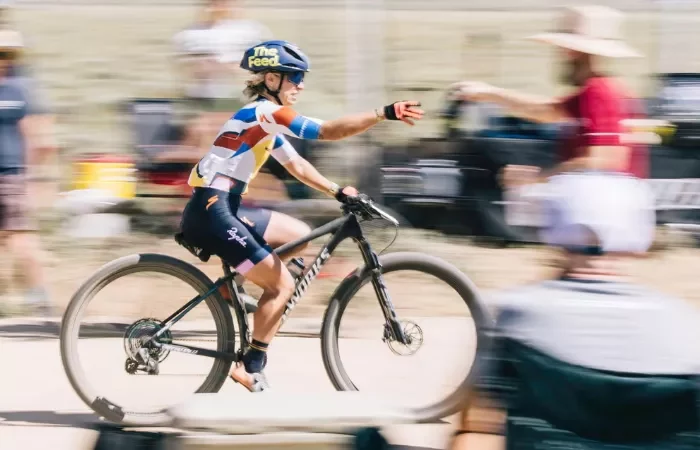In recent years, a notable trend has emerged in professional cycling as more American riders abandon traditional European circuits in favor of gravel racing events back home. This shift offers less support but increased opportunities for independence and financial gain.
Peter Stetina, a former competitor in the World Tour, likens that environment to the structure of major American sports leagues. “The World Tour is like being in the NFL or NBA,” he explains, having raced for several teams from 2010 to 2019. In the World Tour, riders are drafted, sign contracts, and focus solely on racing. The competitive atmosphere is intense, with resignations often influenced by performance.
In 2019, Stetina leveraged his Trek-Segafredo contract to participate in American gravel races, where he achieved significant success, winning the Belgian Waffle Ride and finishing second at the prestigious Unbound Gravel. However, his success led to tension with team management, who preferred that he concentrate on European competitions. Ultimately, Stetina chose to transition to gravel racing full-time, drawn by the autonomy and financial prospects it provided.
Gravel racing encompasses a variety of unpaved terrains and distances, offering a fresh alternative to traditional road cycling, which has seen a decline in popularity in the U.S. since its peak during the early 2000s. Factors such as doping scandals and increasing dangers from distracted drivers have contributed to the downturn, resulting in the cancellation of major events like the Tour of California. Currently, only 15 Americans compete on the 18 World Tour teams, the lowest figure since 2008.
As road cycling wanes, gravel racing has surged, especially in the wake of the pandemic. Gravel bike sales doubled in both 2020 and 2021, and Strava reported a 55% increase in gravel rides in 2023, the highest activity rise on the platform.
The LifeTime Grand Prix, a seven-race series regarded as the premier gravel circuit, has further catalyzed this growth. With a $300,000 purse split among the top male and female competitors, the series attracts a diverse array of athletes, including ex-World Tour riders, cyclocross competitors, and up-and-coming talents.
The cultural differences between road and gravel cycling are stark. Road cycling is characterized by its rich traditions, epitomized by events like the Monuments and Grand Tours. Conversely, gravel racing is marked by its exploratory spirit, making it particularly appealing in the U.S., where a significant portion of roads remain unpaved.
“Road cycling is a tradition-bound sport,” notes Payson McElveen, a two-time national mountain bike champion. He appreciates that gravel racing permits individual expression and creativity, which is often stifled in the more rigid World Tour framework.
As privateers, these gravel racers operate as one-person teams, allowing them the freedom to select sponsors and manage their schedules. This independence, however, comes with its challenges. Riders must be adept at logistics, social media, and contract negotiations while maintaining their training regimens.
Stetina emphasizes the importance of time management in this model, stating, “It’s a constant game of prioritization.” While this responsibility may not suit everyone, an increasing number of riders are opting for the freedom that privateering offers, along with the potential for higher earnings.
McElveen admits that compensation is a significant factor in this shift, noting, “There’s no ceiling to what you can make, unlike the World Tour.” He estimates that roughly half of the 60 riders in the Grand Prix are privateers, with varying levels of success.
Alexey Vermeulen, who began his career with LottoNL-Jumbo, now earns a six-figure income as a privateer—substantially more than he did in the World Tour. After being released from his contract in 2019, he pivoted to gravel racing and faced initial financial challenges. However, he found success in subsequent seasons, finishing second overall in both 2022 and 2023.
“I miss the history and romance of the World Tour, but my personality is a better fit for privateering,” Vermeulen says. He balances racing with producing content for social media, including a popular YouTube series featuring his dog, Sir Willie the Wiener, which has garnered significant attention and boosted his brand visibility.
Sarah Sturm, a two-time Cyclocross National Champion, experienced rapid success after transitioning to gravel racing following the dissolution of her cyclocross team. Her victory at the BWR and additional podium finishes quickly elevated her profile in the sport.
“The amount of sponsorship offers after my BWR win was eye-opening,” Sturm recalls. “Gravel racing has grown immensely, but it remains a wild west of sorts.” She emphasizes that personal branding is essential, noting that personality often outweighs race results in attracting sponsorships.
Sturm’s marketing background has enabled her to navigate the business side of privateering effectively, making her one of the highest-earning athletes in the sport. “Unless you’re winning consistently, results alone won’t suffice,” she adds.
Despite the individualistic nature of privateering, many riders benefit from substantial support networks. Hannah Otto, an Olympian and Mountain Bike World Cup winner, transitioned to privateering in 2022 after nine years on various teams. “The privateer model is new to cycling, but it’s been established in sports like golf and surfing for a long time,” she explains.
Otto has seen her earnings increase significantly since adopting this model, particularly after winning the Leadville 100. “Winning a big race changes the math,” she states, highlighting the stability that comes from diversifying income across multiple sponsors.
The rise of privateers reflects a growing alignment with American cycling culture, which values entrepreneurial spirit and individualism. As McElveen notes, “The world is watching American cycling closer than ever.” With gravel racing leading the way, there is renewed interest in the future of cycling in the U.S. and the potential influence of privateers on the broader sport.
Related topics:
- Archibald Shines in Gold Comeback at Cycling World Championships
- Gathr Outdoors Provides Essential Gear to Hurricane Helene Survivors
- Prepare Your RV for Winter: Essential Tips from Truma

